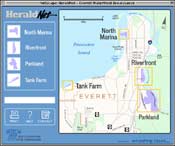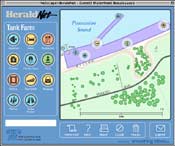Residents Laud Mapping Project; Seek Even More Choices
By Catherine Lee
Pew Center
 Dean Nichols was surprised when he clicked on The Herald’s state-of-the-art Internet map and found no specific icon for a soccer field. Susan Adams found no fish icon reflecting the plight of endangered salmon around Everett, WA.
Dean Nichols was surprised when he clicked on The Herald’s state-of-the-art Internet map and found no specific icon for a soccer field. Susan Adams found no fish icon reflecting the plight of endangered salmon around Everett, WA.
But that didn’t stop Nichols, Adams and hundreds of other residents from responding to the newspaper’s survey seeking their vision for about 600 acres of land along Everett’s waterfront. They responded on forms printed in the newspaper and via a unique clickable Internet map from their home computers.
Despite a few glitches with the technology, The Herald’smethods for gathering ideas worked and last month the newspaper tabulated the survey results and presented them to city officials.
The Herald used a four-part newspaper series, custom-made computer technology and town-hall meetings to encourage its readers to consider the possibilities for transforming undeveloped and inaccessible land into usable space.
Steve Powell, The Herald’s communities editor, said he learned that “paying attention to details is critical to this kind of project.” If anything, he said readers wanted more choices and an icon “for other ideas.”
Interaction Pays Off
Still The Herald’s “Waterfront Renaissance” project made a substantial difference in the way the newspaper communicates with its readers.
“Interacting with our readers on the project has already paid off,” Powell said. “The project produced really good feedback from the community.”
The newsroom saw the project “as a brainstorming session: Dare to dream,” he said. “We weren’t trying to come up with solutions, just ideas. The public and leaders will have to decide which of the ideas will work.”
At first, city and port officials were wary, afraid that the project might confuse residents and raise unrealistic expectations about what could be built on the waterfront. But as the project progressed, city officials came to appreciate the benefits of greater public participation.
Paul Roberts, Everett’s director of planning and community, credited the paper “with some very good work. I’m impressed with their approach and their openness.”
The Herald’s readers were pleased with the efforts to involve them in a public development choice. The project paralleled the city’s work on a shoreline plan. Everett is surrounded on three sides by the Snohomish River and Port Gardner Bay. Two sites bordering the bay are paved over; the two river locations are the site of an old lumber mill.
“I thought it was a great service,” said Nichols, who runs an Everett travel agency and a storage facility management company. “It allowed more people to participate in the process. There are a ton of people who aren’t going to come to meetings. If you can give them information that’s helpful and accessible, that’s great.”
Clicking on Web Maps
To make the process fun and informative for residents, the newspaper created a clickable map for its Web site. The map enabled readers to view four waterfront sites and to decide how they’d like them developed by clicking on different icons, representing parks, ballfields, open space, a museum, a boardwalk, a restaurant, a scuba diving center and other attractions. A baseball icon, for instance, represented a ballfield.
Nichols, who runs an annual soccer tournament, would have liked an icon specifically for a soccer field. “I think The Herald needed to provide more options.”
Adams, director of the SmartGrowth campaign for the Pilchuck Audubon Society, would have liked a salmon icon, promoting the preservation of the endangered species. At the same time, she credited the project with generating “really good conversation all over town.”
Mark Briggs, The Herald’s new media editor, said that in deciding which icons to provide, the newspaper “tried to draw on its experience with the community. We were afraid that too many icons would dilute the feedback.”
 The map had nine to 12 icons for each waterfront site. “We tried to represent similar visions with one icon,” Briggs said. While there was no specific soccer icon, the ballfield icon represented any outdoor athletic field.
The map had nine to 12 icons for each waterfront site. “We tried to represent similar visions with one icon,” Briggs said. While there was no specific soccer icon, the ballfield icon represented any outdoor athletic field.
The level of demand for salmon and habitat restoration icons surprised the newspaper, Briggs said. When Herald staff members met last fall to choose the icons, they thought more in terms of land use, not water use, he said.
“In terms of the [fish] icon, I think it’s kind of looking at the same issue in two different ways,” Briggs said. “This was a tremendous learning experience and there really was no model to follow. There are certainly things that we would do differently.”
The Herald had hoped to provide a “wild card” icon that would have allowed residents “to choose from anything under the sun” but the cost of the technology was prohibitive, Briggs said.
In hindsight, Powell said the newspaper should have had an icon that represented “no development,” a sentiment expressed in a petition The Herald received on the final day to return surveys. The petition carried the signatures of 300 residents who don’t want anything done at the waterfront.
According to the survey results, parks were the most popular choice for three sites, and the second most popular at the fourth site. The results included 420 maps done on the Internet and 597 done on paper.
Earlier, a four-part series by reporter Kate Reardon described the waterfront now, what could be developed, and how eight other cities in the Northwest used private and public funds to make their waterfronts more viable.
In addition to the clickable Web map, The Herald met with neighborhood groups throughout Snohomish and Island counties to get their ideas.
The newspaper hired a bus and took about 30 people on a tour of the sites and held a town meeting where a national waterfront-development expert spoke about what had been done in other cities.
The paper also helped to set up four independent watchdog groups that will keep an eye on waterfront development after The Herald project ends, Powell said.
Before The Herald embarked on the project, staff members met with city and port officials to share their plans. At the time, the city updating its shoreline master plan, now under review by the Washington Department of Ecology.
Those meetings sometimes raised eyebrows and some interesting questions.
“We appreciated the opportunity to meet with them ahead of time,” said planning director Roberts. “But it created an interesting dichotomy. We had just spent two and a half years working on our shoreline plan and then The Heraldwanted to start all over again … Their timing was awkward.”
Reardon said that the newsroom “felt that the timing was not a big issue.”
“We were asking the public to dream about what the land could be used for in the future,” Reardon said. “We weren’t suggesting anything so outrageous that you’d have to change the zoning.”
Reardon said that the series prompted residents to attend the state Ecology Department hearings, which drew crowds of about 100 people.”I don’t think they would have drawn as many people without the series,” she said.
Roberts acknowledged that the survey results could prove helpful as the city continues its waterfront planning but he also raised a philosophical question about the newspaper’s role.
“In our system of government, we elect people to make decisions and we have a very detailed procedure for getting public input,” he said. “We don’t get to elect editors or writers. Is there a potential conflict with the newspaper stepping in like this? Are we mixing our roles by having the paper be proactive?”
At a meeting last May with about 45 residents of the city’s historic Lowell neighborhood, Powell dealt with misconceptions about the project. Powell had hosted the community meeting, one of about 10 last spring, to show a video about development possibilities. Residents of Lowell, which is adjacent to one of the riverfront sites, are opposed to developing the waterfront.
The residents accused the paper of being pro-development.
“We had to explain what our role is,” said executive editor Stan Strick. “We’re journalists. We’re catalysts. We’re facilitators. That’s where we stop.
“What our series accomplished was really consciousness raising,” Strick said. “Land use is important but sometimes not very high profile. Like many zoning and land issues, you mention it and people’s eyes glaze over.”
In June, Reardon spoke to a group of high school students whom The Herald honored for their achievements in journalism. Reardon said that she had “kind of a realization” as she addressed the students.
“I told them that as a reporter you think you’re doing pretty well if you talk to three to five sources,” Reardon said. “If you think about it, there are so many more ways to tell a story. I realized how limited most reporters are with a story, especially when we go to the same sources all the time. With this project, I now have 1,500 sources. I realized how many people I had reached out to.”
